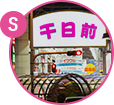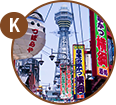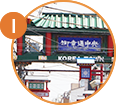
The Best Japanese Breakfast Spots in Osaka
2025.05.16


Written by: Shino(Shino)
● A Full Breakfast to Start the Day
Breakfast is a special time when you’re traveling.
At home, you might grab a coffee and a toast to run out the door. On vacation, on the other hand, breakfast is a luxury you can take your time to savor before you start your busy day. And, breakfast in Japan is a cultural experience in itself.
I know exactly where you can go in Osaka to have an excellent meal to start your day♪
● The Japanese Breakfast

Let’s first talk about Japanese breakfast.
Freshly cooked white rice is at the center of all meals in Japan. In the Japanese language, rice is commonly referred to as shushoku, which literally means the “main food” of a meal, while meats and vegetables are okazu, the dishes that accompany rice. So, naturally, rice is imperative even in the case of breakfast in Japan.
The Japanese look at rice as the main source of energy. During the Edo period (1603-1868 CE), it was normal practice for a Japanese to consume 5 cups of rice each day and a typical breakfast included a bowl of freshly cooked rice accompanied by a bowl of miso soup and pickled vegetables.

At the foundation of a Japanese breakfast (or meal) is Ichiju Sansai. Literally meaning “one soup three dishes”, it refers to a menu that consists of rice accompanied by soup and three okazu dishes. (Note rice is not even mentioned because it’s that essential.) Typically, this includes a bowl of miso soup, one protein dish such as grilled fish, Japanese omelet, or other meat, fish, egg, or soy bean dish, and two vegetable or seaweed dishes like kinpira gobo (braised burdock root) and spinach ohitashi (blanched spinach in a dashi marinade).
With the practice of Ichiju Sansai, a Japanese breakfast offers an excellent nutritional balance and is associated with longevity. In other words, with Japanese breakfasts, you are getting both animal and plant proteins while reducing fat in your diet, effectively achieving a healthy, yet delicious, life.
● Japanese Breakfast Staples
Among various menus that are available, here is a selection of most common breakfast staples often prepared at home in the morning♪
・Miso Soup

Miso soup is a traditional Japanese soup made with dashi broth flavored with miso (fermented soy bean paste) and ingredients like tofu and seaweed. A bowl of hot miso soup warms your entire body and puts a smile on your face.
Ingredients used in miso soup typically include tofu, seaweed, fu (what gluten cakes), spinach, carrots, and onion. Each household has their own variation, and it can also vary by season.
・Grilled Salmon

One of the top proteins served at breakfast in Japan is grilled salmon.
While salmon is a fatty fish, it’s a great source of omega-3 fatty acids, and the mild saltiness and its fluffy texture of a grilled salmon is a great match for white rice.
・Tamagoyaki Japanese Omelet

Tamagoyaki is a Japanese omelet made in a special rectangular pan in which thin layers of fried beaten eggs are carefully rolled on top of one another. Light, mild, and slightly sweet tamagoyaki adds a bright color to the table and is a staple in Japanese breakfast menus as well as sushi toppings and bento boxed lunch.
・Tamago Kake Gohan

Often served as part of breakfast at ryokan Japanese inns, tamago kake gohan is a simple dish consisting of hot cooked rice mixed with fresh raw egg and a dash of soy sauce. Consuming raw eggs may not be as common outside Japan but try it once and you’ll love the simple yet addictive flavor of a Japanese favorite!
Now that we’ve covered the staple breakfast menu items, let me show you where you can get these delicious Japanese breakfast★
● 【Minamimorimachi Station】 Onigiri Rice Balls at Musubiya

Onigiri is at the heart of every Japanese. It has also reached different parts of the world nowadays. For all those onigiri fans, we found Musubiya, a shop that specializes in onigiri! About a 2-minute walk from Osaka Metro’s Minamimorimachi Station, Musubiya stands in the midst of numerous shops and restaurants of Tenjinbashi-suji Shotengai shopping street.
Open at 7:30am, Musubiya is a great place to get an early breakfast, before a full day of activities.

Showcased in the shelves in front of the store are about 15(!) flavors of onigiri. Every flavor sound appetizing to a hungry belly in the morning. The lineup includes staples like kombu (kelp) and salmon, as well as other unique fillings like soy flavored asari clams and cucumbers pickled with green chilies, red chilies, and its leaves. I personally like the simple salted onigiri…and mentaiko spicy cod roe…and chirimen jako, dried baby sardines…and…!

The dine in menu includes two set menus: “Onigiri Breakfast” (660 yen incl. tax) and “Onigiri Set” (880 yen incl. tax).
While Onigiri Breakfast is served only from open to 11am and includes two onigiris of the day and miso soup, Onigiri Set includes two onigiris of your choice, miso soup, and two small sides.

I ordered an Onigiri Set so I can personally select the flavors. After much consideration, I decided on ume plum, the most standard of onigiri (and they use nanko-ume plum from Wakayama, the best in Japan in my opinion!), and meat soboro, crumbly meat flavored with soy sauce and mirin that’s popular among both Japanese and foreign customers.
My two large onigiris came with a bowl of miso soup made with basket clams and three small sides of tamagoyaki Japanese omelet, kinpira gobo burdock roots, and Japanese mustard spinach and deep fried bean curd cooked in dashi broth.

Ume onigiri was packed with filling and topped with a generous amount of ume paste.
But the first bite was filled with the flavor of yummy rice. At Musubiya, they use hitomebore, a premium brand rice from Tottori Prefecture. The crucial step in making onigiri is when you take rice into your hands and shape it into a triangle. You need to apply enough pressure, so it doesn’t fall apart, but you also don’t want to press it too much. Musubiya has mastered this art and their onigiri is perfectly fluffy. The rice comes loose lightly only inside your mouth, and you can savor every grain of it.
Nanko-ume has a nice touch of sourness and the meat soboro was quite filling♪

Miso soup comes in two flavors depending on the day: tonjiru (pork and vegetables) or basket clams. I had the basket clam miso soup which had plenty of clams in it. A hot bowl of soup was delicious and sumptuous on a cold morning.
The set with two onigiris is plenty enough, but there’s an option to add more or get more to go if you feel the need.
● 【Taisho Station】 Tamago Kake Gohan at Choshokuba Nagayado

One of the Japanese breakfast staples, tamago kake kohan, is actually not easy to find at restaurants, but you can enjoy it at Choshokuba (literally means “breakfast place”) Nagayado located in a quiet shitamachi old town about a 5-minute walk from Osaka Metro’s Taisho Station.
Only a 10-minute subway ride from the popular Shinsaibashi area where many travelers find lodging, Choshokuba Nagayado is very accessible from the city center.


Built as part of the chic Hostel Nagayado Osaka, Choshokuba Nagayado is housed in a renovated 100-year-old rowhouse that was originally constructed during the Taisho period (1912-1926). The combination of the old and the new creates a comfortable space for visitors to enjoy their time there.

I had the Tamago Kake Gohan Set in this lovely place for 1,000 yen (incl. tax). Look at this beautiful Japanese breakfast! The orange yolk is shining on top of the bowl of rice, served with a bowl of tonjiru and seasonal sides.

Tamago kake gohan at Choshokuba Nagayado is not an ordinary tamago kake gohan you might find elsewhere. It takes much more to make it than simply cracking an egg and pouring soy sauce on top of rice.
First of all, the eggs they use are Ryunotamago, top brand eggs known for its high nutritional value and robust flavor. And, instead of simply dropping it on rice, they marinate the yolk in smoked pure soy sauce and cooked mirin for one day. The result is a golden yolk with intensified umami and no excess water. This deliciousness is then placed on hot fluffy rice cooked in a donabe earthen pot.

Too often, tamago kake gohan gets a little wet with the moisture from the egg while eating, but at Choshokuba Nagayado, the yolk is so thick, you’re almost “painting” the rice with it. The fluffiness of rice is thus preserved and can be enjoyed with the egg full of umami.

To add variations to the flavor, you can use smoked salt and/or smoked olive oil if you so wish. Salt is always a good addition, but I especially liked the olive oil. By adding a little bit of olive oil, the classic Japanese breakfast evolved into a dish with a Western touch! And the newly created flavor was almost addictive.

On the side of the tamago kake gohan were small plates of seasonal vegetables♪ Romanesco broccoli served with leaf mustard mayo, rapeseed cooked in wasabi flavored dashi broth, and creamed nappa cabbage all made me feel that spring was on its way. I felt delighted and wholesome to be eating fresh seasonal vegetables and the tasty, substantial tonjiru miso soup.

If you’re feeling a bit fancier, you can have the Nagayado Set (2,200 yen incl. tax) and enjoy their afternoon-tea-like menu.
※A four-day advance reservation is required for the Nagayado Set (2,200 yen incl. tax). Reservations can be made by phone or via DM.

I can tell you the hojicha mousse included as part of the Nagayado Set is particularly exceptional. The sauce seasoned with a secret ingredient Japanese prickly-ash served on top of the rich hojicha mousse was just phenomenal.

I had the pleasure of meeting Katayama-san, the chef that makes these beautiful and tasty creations. She is a gentle soul who loves to cook.
By all means, visit this wonderful space that serves exquisite breakfast and enjoy a nice, slow morning in Osaka.
● 【Hommachi Station】 Japanese-Western Fusion at Warewarewa
A stylish breakfast restaurant Warewarewa sits on Semba Dobuike Street, about a 3-minute walk away from Osaka Metro’s Hommachi Station.

Breakfast starts at 8am at Warewarewa. Through the noren curtains, let’s take a peek into the restaurant♪


This is the Morning Onigiri Rice Ball Set (1,200 yen incl. tax). The flavors of the cute round onigiris are, from left, mentaiko (spicy cured pollack roe), plum shiso kombu, and mushroom miso. Rice had a glutinous texture and was flavorful. I enjoyed them with the Japanese breakfast staples, tamagoyaki Japanese Omelet and grilled salmon.

The Morning Onigiri Rice Ball Set offers a variety of flavors and just the right amount of food for breakfast. The variation of the additional sides changes every season but on the day of my visit, they included beef shigureni—beef simmered in soy sauce and mirin with ginger, deep fried vegetables, and deep fried chikuwa fish cake seasoned with seaweed.

So, what do you think about the Japanese breakfast in Osaka?
Evey dish I tried was excellent, and the wide variety of foods was all presented in carefully selected dishes that bring out the best of the food ingredients. It’s an art, really.
Breakfast is often called the most important meal of the day. Whatever you normally eat (or not eat) at home, try different breakfast options while visiting Osaka and enjoy the “unforgettable flavor” of the Japanese breakfast♪
Spots Introduced
The Handmade Onigiri Shop Musubiya
[Access] About 2 mins walk from Tanimachi and Sakaisuji Lines’ Minamimorimachi Station Exit 4
[Hours] Weekday/7:30 am - 8:00 pm
Saturdays,Sundays,Holidays/7:30 am - 5:00 pm
[Closed] Open Every Day
Choshokuba Nagayado
[Access] About 5 mins walk from Nagahori Tsurumi-ryokuchi Line's Taisho Station Exit 2
[Hours] Thursday - Sundays, Holidays/8:00am - 11:00am
[Closed] Monday - Wednesday
Warewarewa
[Access] About 3 mins walk from Midosuji and Chuo and Yotsubashi Lines’ Hommachi Station Exit 12
[Hours] 8:00 am - 4:00 pm (L.O.3:30 pm)
[Closed] Open Every Day
Recommended Plans

The Newest Sumo Entertainment in Namba
The Sumo Hall Hirakuza Osaka is the newest addition to Osaka’s entertainment district, …
2025.08.15

Tea Time at A 400-Year-Old Temple♪
Hi! My name is Youn. I'm from South Korea. Temple cafes are becoming a thing in Japan …
2025.05.09

A Cozy Winter Evening at Japan’s Tallest Building
It’s still cold outside and the air is clear, so we took a trip to the top of Abeno Harukas for …
2024.11.29
Minamimorimachi
Minamimorimachi
Taisho
Hommachi
Hommachi
Hommachi



















